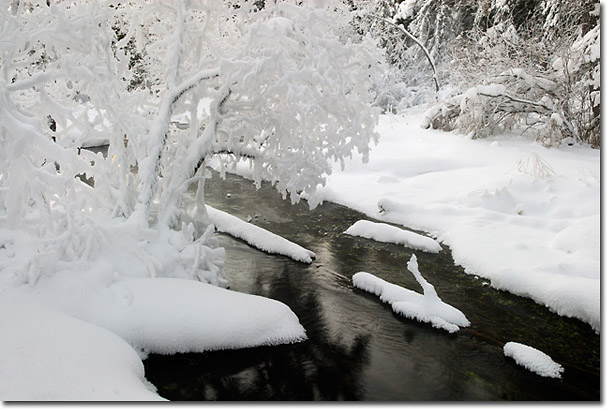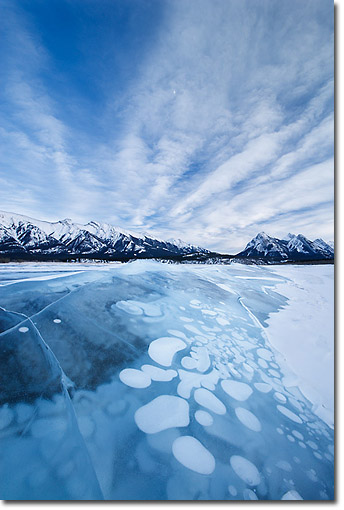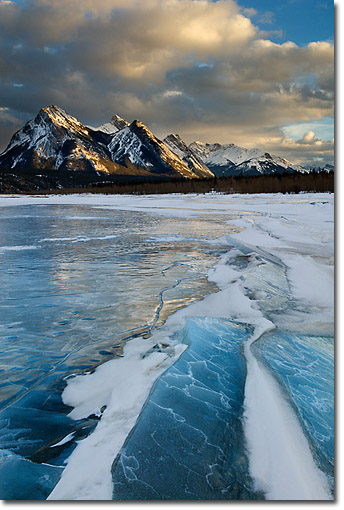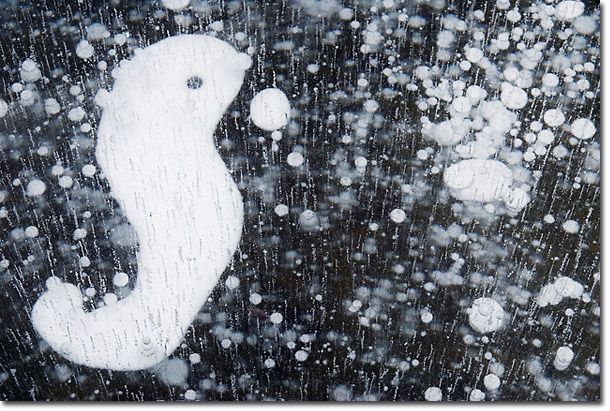Frozen Waters: Capturing the Stark Beauty of Wonderlands in Ice |
Tired of the usual summer, iconic mountain scene? If you are prepared to go out in the winter chill, you can capture spectacular images in nature that are, literally, right at your feet.
Shooting in winter or cusp seasons like spring or fall can provide exciting, fresh images if you change your focus to take advantage of what is before you. Many photographers have mastered the art of the summer, mountain-reflection landscape. But for something different, do not put your camera away when the mercury starts to drop! Water is a fascinating element, and working it in its solid form into your images can produce drama, dynamic compositions and a unique take on a frozen world. Here are three tips for the next time you venture out into the wild world of ice!

A Note on Being Prepared
In addition to your usual camera equipment, you may want to invest in a few, small other items. First, if you shoot digital, make sure to bring extra batteries as the frigid air takes a huge toll on the functionality of digital cameras. Second, you will definitely want to dress for the winter. Many of us think we know how to do this as adults, yet I am continually surprised to hear of people travelling in their vehicles without extra warm clothes for emergencies, or even shooting in the field without proper, warm, outdoor clothing. Hypothermia is a real danger in these situations and can overtake you quickly. If you are unsure what constitutes proper winter wear, most outdoor clothing stores will be happy to "enlighten" your wallet.
Another tip is to insulate your tripod legs. When out shooting, my fingers are the first casualties as they are in continual contact with freezing metal and plastic. I wear two gloves, but find the extra step of insulated tripod legs really works in the field. There are products out there that do the trick, or you can wrap a skinny foam pad around each leg and tape over it with hockey tape. Not pretty, but functional.
Finally, if you are planning on stepping out on frozen ice, seriously consider investing in some cleats or spikes for your winter boots. These can help you get closer to that waterfall, climb that small lip of ice or save you from a painful (and expensive!) fall. Oh, and if you're on the lake on a windy day, be very careful changing lenses. I can still hear the small clicking of grit in my lens after being out one particularly windy day.

Tip #1: The Power of Ice as a Foreground
Without the formula of a reflection to fall back on, a photographer is forced to interact with the landscape before him in a different way. The answer could be right at his feet! A tightly composed image can be made by paying close attention to how the foreground can fit into the middle and background of our image. For example, when I arrive on location, I usually spin 360 degrees to get a feel for what is around me and what the light is doing. I then look at the ground to see if there are any interesting textures or lines that might lead me to something else. In shooting frozen water you have the opportunity for so many lines and textures. Ice can be a colourful, graphic element to draw the viewer into the scene. Work with this gift: look for long, jagged cracks, drifting "snakes" of snow blown into crusts across the icy surface of a lake, or the edge of a sheet of ice thrust along a river's shore.
Then, see if these lines lead to any other element that may become part of your subject - a towering mountain in the distance, or a lingering star hovering over the scene. If you are lucky, you may be able to find cloud patterns that either complement or even mimic the line or shape of the ice pattern.
If you are taking pictures on a cloudy day, there may be little contrast in the scene because the ice mirrors the sky. At this point, see if any filters or polarizers might add some colour. A blue-yellow polarizer may give a subtle glow to the ice or intensify any blue hue in the depths. If there are any moving clouds, sometimes a neutral density filter used in combination with a regular polarizer can "push" the magenta colours in the sky and streak the clouds for a more dreamy effect. Experiment! The key is to learn to see how the light reflects off the glassy surfaces before you to highlight the natural beauty held within the ice.

Tip #2: Shoot Classic Summer Scenes in Winter
Much of the public knows an icon by its usual presentation: a sunny, summer portrayal. By returning to iconic scenes with the potential of frozen water, you can capture a refreshingly original portrait of the icon.
The trick here is to show the icon in a new and interesting light. Sometimes just being there at a different time of year presents amazing scenery! Or you may try a different viewpoint, such as a wide-angle view with a prominent, icy foreground. As with shooting grand scenics in general, you are searching for a way to tie together a dynamic element like ice into the frame. Work the unique properties of ice into the story you are telling. For example, sometimes strange bubbles and cracks in the ice create an almost alien landscape.
Or you could shoot an iconic subject - like waterfalls - in a manner that shows the beauty and form of the fall frozen in mid-air. If you know of falls that are partially frozen, you may incorporate the best of both worlds. Arriving early morning on particularly cold days will allow you to capture backlit clouds of fog lifting off the rushing waters. In fact, searching for combinations of frozen and open water can add contrasting textures and colour to any scene.

Tip #3: Intimate Abstractions
A simple story is often the most effective. The idea behind a single subject quickly connects with the viewer's imagination. Ice lends itself well to abstractions which allow the photographer to convey her ideas in a more metaphorical way.
I look for things trapped in the ice. The feeling of being "caught" or "stuck" is a powerful emotion that can lend gravity to an image. The image of bent, yellow reeds frozen on the shoreline provides a sense of time suspended and the trough in the cycle of seasons. For more cheerful imagery, ice bubbles can sometimes form themselves into surprisingly life-like shapes. The strange icicle shapes along the edges of half frozen, flowing water are reminiscent of jewels or frosty stars. With abstract, intimate portraits, the wings of the photographer's imagination can really lift the story into another level.
Living in Canada, I have the privileged position of being able to shoot ice 300 days of the year! While this may be a (slight) exaggeration, I have come to appreciate the diversity that frozen water can add to my work. The ice can be subtle or dramatic, depending on how it dances with its partner, the light. But the depth of the world in which I am drawn never fails to inspire.
Comments on NPN nature photography articles? Send them to the editor. NPN members may also log in and leave their comments below.
Samantha Chrysanthou was born in Lethbridge, Alberta. After moving for a period of time to northern Alberta, she returned in 2000 to southern Alberta to pursue a law degree in Calgary. After becoming a lawyer, Samantha began to realize her heart was more engaged in capturing the beauty of the landscape around her than debating the nuances of legal arguments in court. She has since left law to pursue writing and photography full-time. She particularly enjoys shooting the prairies, foothills and Rocky Mountains within an hour or so of her home in Cochrane, Alberta. Visit Samantha's website to view more of her work at www.chrysalizz.smugmug.com.